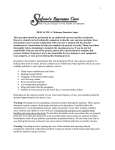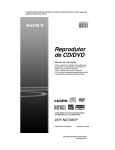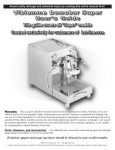Download Vetrano Espresso Machine Installation manual
Transcript
Digital Thermometer & Adaptor for E-61 Groupheads November 20, 2007 Introduction: The purpose of this adaptor and digital thermometer is to facilitate the measurement of brew water temperature about 1.25" away from the puck during a brew cycle. In addition, and EQUALLY IMPORTANT, it measures the temperature of the grouphead at the indicated location under idle conditions. It requires no drilling, tapping, soldering, brazing, cutting, teflon tape, or epoxy but is ONLY capable of fitment to E61 groupheads that are fully exposed. The difference between the temperature that you will be measuring using this adaptor and measured temperature of the water hitting the puck is approximately 3-5 degrees F but may vary with different machines and different brew conditions and most certainly, varies over the course of a typical 23-27 second shot. Indicated temperatures will be higher than those presented to the puck when using the flush-n-wait technique whereas indicated temperatures will be lower than those presented to the puck when using the flush-n-go technique. There have been several successful adventures in measuring brew water temperature in espresso machines. The best example would be the Scace Thermofilter available from this espresso supply house: http://www.espressoparts.com/ It is a well-engineered device, designed to measure brew temperature during an accurately simulated double-shot brewing process. Instructions for the use of this device and a professional review of it can be found here: http://www.home-barista.com/forums/viewtopic.php?t=453 1 Background: This adaptor is identical to the original thermocouple adaptor except that the “boredthrough” size of the fitting is 1/8” (0.125”) vice the original adaptor which has a bored through size of 1/16” (0.0625”) and the overall length is increased by about 3/16”. In addition, the width of the 7/16” hex on the main body has been shortened to enable installation in Vibiemme Domobar machines without adding any additional copper washers. The advantage to this device is that it is a complete solution to the task of measuring temperature whereas the original thermocouple adaptor requires a thermocouple and appropriate meter. The disadvantage of this device when compared to the original thermocouple adaptor is in accuracy, response time, and temperature readout resolution (depending on the meter used with the original thermocouple adaptor). My preference, of course, is the original thermocouple adaptor (and that is what I use) but sometimes the SO’s in our lives do not necessarily want the kitchen turned into an espresso laboratory and, sometimes, we do not want it either. Development: This device is “sorta” modeled after the temperature monitoring device made by Dave Stephens (Cannonfodder) which consisted of a digital thermometer probe shortened and brazed into a drilled M6 bolt. The great majority (if not all) of digital pocket thermometers are now made in China and most have a 5” stem with a diameter of 0.151 inches. There are some with stem diameters of 0.137 inches but why the stems have these diameters is beyond me because they do not translate into any common english or metric dimension. Most digital pocket thermometers utilize a small, negative temperature coefficient (NTC) thermistor (either 50K or 100K ohms @ 25 °C) to sense temperature. Some of these thermometers, which utilize the words “quick tip” in their description, have the thermistor potted (glued) in the tip while the great majority of these thermometers simply have the thermistor somewhat forcibly located at the end of the probe, about 1/32”-1/16” from the tip of the point. I contracted with a company that manufactures thermistor probe housings to build a special tip for me (and you) as shown above. Removing the original probe sheath from purchased digital thermometers is easy as 2 they are simply a very light press fit and will pull out with ease and a slight alternating, twisting motion. Putting the probe in a vise makes the job very easy. And, by the way, I will now (4/17/07) start shipping the digital thermometer adaptor kits with the old probe housing loose as it can be used very effectively with the Weiss Distribution Technique (WDT) – See here: http://www.home-barista.com/weiss-distribution-technique.html This leaves you with this: All you need to do now is to apply about 2.75” of 1/16” heat-shrink tubing, letting the thermistor protrude about 1/4”. The heat-shrink tubing adds a nice bit of stiffness to the wiring assembly when it is inserted into the probe housing. Now apply a dab of Omegatherm 201 (high thermal conductivity paste) to the thermistor element and then press the new modified tip into the plastic housing. 3 Kit Contents: a. Stainless steel adaptor (Swagelok P/N SS-200-1-0221BT or equal) fitted with replaceable nylon ferrules and a modified Taylor Model 3516 digital thermometer or, optionally, a Taylor Model 9841 digital thermometer (°F / °C switchable). b. Two 6 mm copper sealing washers (one for installation, one as spare) c. Adaptor closure plug (should you want to temporarily suspend the temperature measuring adventure) d. One set of spare nylon ferrules (front and back) for adaptor e. Original 5” long probe housing with pointed tip (good for use with the WDT (see text) f. Spare battery Breaking News (10/12/07) – the digital thermometer kit is now available with a Taylor Model 9841 thermometer which is switchable from degrees F to degrees C. It is a small additional amount which reflects the higher cost of the thermometer and a tiny bit extra in assembly time. 4 Enhanced Kits: The primary purpose of the adaptor is to allow the use of the modified digital thermometer to assist in making your espresso better and more consistent. However, once the adaptor is installed, there are very inexpensive options available that would greatly enhance the utility of the adaptor. These enhanced kits are separately priced as shown on the Pricing_Inventory_Ordering pdf document available here: http://users.rcn.com/erics/ Digital Thermometer Adaptor Kit Enhanced Kit to facilitate the use of any 1/8” thermocouple – thermocouple not included Enhanced Kit to facilitate the measurement of actual brew pressure – use ¼” NPT gage 5 Checking the Accuracy of the Thermometer: The 3516 digital thermometer included in this kit is not capable of being calibrated but it is easy to check its accuracy and speed of response by suspending the tip into the steam portion of a pot of boiling water or a thermos jug/jug cap filled with a distilled water / ice slurpy mixture. Note your current altitude, e.g., Silver Spring, Maryland is about 300 feet above sea level; Denver, Colorado is slightly more. Note your current barometric pressure e.g. 29.92” Hg, 28.96” Hg, 29.54” Hg, etc. You can use this website to determine water’s boiling point: http://www.hi-tm.com/Documents/Calib-boil.html For example, the current barometric pressure in Silver Spring, MD is 29.99” Hg referenced to sea level and if I were at sea level, the boiling point of water would be 212.1 degrees F. However, because Silver Spring averages about 300 feet above sea level, the boiling point of water at the current barometric pressure is 211.6 degrees F. Suspend the probe end of the digital thermometer into a pot of vigorously boiling water and observe the meter reading with the probe suspended in the steam. Punch a 1/8” hole into a 2” x 2” piece of cardboard to avoid steaming up the underside of the thermometer. A simple teakettle would also be fine for this purpose. Make both a mental and physical note of the reading. Recheck, as you feel necessary. 6 Another method of “checking” YOUR digital thermometer kit is to immerse the thermometer tip in a covered short thermos jug filled with a mixture of crushed, distilled water ice and distilled water – think of a flavorless coarse slurpy. This method is nice because it is independent of altitude and barometric pressure but needs about 15 minutes or so to stabilize around the established freezing point of water (32.0 F). Each digital thermometer is shipped with a tag attached to the probe stem. The small writing at the bottom shows the temperature of boiling water/condensing steam here in Silver Spring, Maryland (MD) for the particular test day conditions, the date of the test, and my initials. The large number shows what the thermometer read while in the “test pot.” Kits shipped with the Taylor 9841 thermometer have one side in degrees Fahrenheit and the other in degrees Celsius. Celsius thermometers are independently tested reading both temperature scales, i.e. the numbers MAY NOT equate mathematically in accordance with the conversion formulas from F to C or C to F. Measuring Probe Depth in the E-61 Grouphead: When the digital thermometer adaptor will be used in a Quickmill machine (Alexia, Andreja, Anita, or Vetrano, the probe will come already adjusted at the proper depth (as of 9/3/07). The recommended depth of the probe for these machines is achieved by having the probe protrude 3/8” beyond the end of the M6 threading on the adaptor. This depth should be very satisfactory for the majority of machines HOWEVER, it only takes about an hour to measure for proper depth. This section details that procedure. 7 The “D” dimension can be measured with a bent paper clip as shown above or with a thin coat hangar to which you can slide a piece of wire insulation or short section of appropriately sized shrink-wrap tubing to use as a “poor man’s depth gage.” Add 1/8” to the measured “D” dimension (to place the thermistor very close to spot X and subtract 0.283” (the effective length of the M6 threads). FOR SOME EXAMPLES: Quickmill machines have a “D” dimension of 17/32” and thus the probe protrusion is set at 3/8” (actual is 0.373”). 8 Vibiemme machines have a “D” dimension of 0.415 and thus the probe protrusion is set at 1/4" (actual is 0.257”). Temporary Installation of Thermometer in Adaptor (at determined probe depth): Slide the thermometer into the adaptor such that the sensing tip of the thermometer is protruding from the M6 threaded end of the adaptor at the previously determined dimension. Make a mark on the thermometer probe housing where it exits the other end of the adaptor. Loosen the nut and slide the thermometer out of the adaptor. (09/03/07) When the digital thermometer adaptor is sold for use in a Quickmill machine (Alexia, Andreja, Anita, or Vetrano, the probe will come already adjusted at the proper protrusion of 3/8”; for the Vibiemme machines, 1/4”. Install the thermometer and adaptor as a unit, turning the adaptor body by hand until it is finger tight (no wrenches). Now, using a 7/16” wrench on the thin 7/16” hex, tighten the adaptor body one-eighth of a turn (45 degrees). Slightly loosen the large 7/16” nut for the ferrules and adjust the orientation of the thermometer. Installing the Thermometer Adaptor (Method I - Long) Turn your machine OFF and UNPLUG it from the wall outlet. Remove the existing M6 x 8 mm allen-head capscrew using a 5 mm long-handle allen wrench. The existing copper or teflon sealing washer will likely come off semi-attached to the capscrew. If not, remove it from the machined recess in the grouphead and set aside as an emergency spare. Clean the recess and the seating surface for the new copper washer with a water-moistened Q-tip as necessary. A few swipes should do it. Slightly loosen the 7/16” nut and slide the digital thermometer out of the adaptor body. Place one 6 mm copper sealing washer on the adaptor fitting and screw it into place in the machine finger-tight. The adaptor should screw in as easy as the M6 allen head plug screwed out – the threading is identical. Do not use any type of thread sealant or teflon tape on the threads of the adaptor. The soft copper washer will deform and thus conform to any surface irregularities and do all of the necessary sealing. 9 NOTE No part of the 7/16 hex should be touching any part of the grouphead. If this is NOT the case, stop all work and give me a call at 301-587-5033 or send email to me at [email protected] as soon as is practicable. Put a small mark on one corner of the 7/16" hex with a felt tip pen. Put a corresponding mark on the grouphead. See illustration above. Using a short 7/16" combination wrench, tighten the adaptor fitting 1/8 turn until the mark on the hex is about 45 degrees from the mark you placed on the grouphead. Do not overtighten. Install the included adaptor closure plug onto the adaptor fitting finger-tight. Note that the adaptor closure plug seals without the use of any ferrules. Using a short 7/16” combination wrench, tighten the plug only 1/8 turn (45 degrees). Plug the machine in, turn it on, and let it reach normal brewing temperature. Pull a shot through an empty basket and look for any leakage in the area of the adaptor fitting. Now put a blind basket in the portafilter and backflush the machine by cycling the pump on for 10 seconds and off for 10 seconds. There should be no leakage from the adaptor fitting. If necessary, tighten the adaptor or the plug (or both) just enough to stop any leaks. 10 Installing the Digital Thermometer: Now that the adaptor has demonstrated itself to be leak free, it is time to install the digital thermometer which you had set aside. Remove the closure plug and set aside. Insert the thermometer all the way into the adaptor fitting such that the mark you previously made is just visible and turn the 7/16” nut just finger tight. There should be ABOUT a 1/4” gap between the body of the thermometer and the adaptor nut. Tighten the 7/16” adaptor nut ½ to ¾ of a turn past finger-tight and no more. Note that the manufacturer’s published instruction for this size adaptor calls for tightening the adaptor nut 3/4 turn. I believe that the half-turn is sufficient to prevent any leakage and will improve the reusability of the ferrules depending upon how often the digital thermometer is removed from the espresso machine. Turn the machine on and let it come to normal brewing temperature. Pull a shot through an empty basket and look for any leakage in the area of the adaptor fitting. Now put a blind basket in the portafilter and backflush the machine by cycling the pump on for 10 seconds and off for 10 seconds. There should be no leakage from the adaptor fitting. Tighten the 7/16” nut connection only enough to correct any leakage. Installing the Thermometer Adaptor (Method II): Those more experienced with “things mechanical” can employ this method. Remove the protective plastic boot. Using your fingers, slightly loosen the 7/16” hex nut and position the thermometer in the adaptor such that the sensing tip of the thermometer probe is protruding 3/8” out of the M6 threaded end of the adaptor for all Quickmill machines or 1/4” for Vibiemme machines. Tighten the 7/16” nut with your fingers. 11 Remove the existing M6 x 8 mm allen-head capscrew using a 5 mm long-handle allen wrench. The existing copper or teflon sealing washer will likely come off semi-attached to the capscrew. If not, remove it from the machined recess in the grouphead and set aside as an emergency spare. Clean the recess and the seating surface for the new copper washer with a water-moistened Q-tip as necessary. A few swipes should do it. NOTE Do not use any type of thread sealant or teflon tape on the threads of the adaptor. The soft copper washer will deform and thus conform to any surface irregularities and do all of the necessary sealing. Install the thermometer and adaptor as a unit, turning the adaptor body by hand until it is finger tight (no wrenches). Now, using a 7/16” wrench on the thin 7/16” body hex, tighten the adaptor body one-eighth of a turn (45 degrees). Slightly loosen the large 7/16” nut for the ferrules and adjust the orientation of the thermometer. Holding the thermometer in proper orientation, tighten the 7/16” nut an additional ½ turn using a wrench. Pull a shot through an empty basket and look for any leakage in the area of the adaptor fitting. Now put a blind basket in the portafilter and backflush the machine by cycling the pump on for 10 seconds and off for 10 seconds. There should be no leakage whatsoever from the adaptor fitting. If necessary, tighten the adaptor body or the 7/16” nut (or both) just enough to stop any leaks. 12 Operation of the Espresso Machine with Digital Thermometer: An E-61 espresso machine having a heat exchanger (hx) can be operated in numerous ways. I will attempt to explain two methods that certainly achieve the same results but differ by 180 degrees (NOT temperature degrees) in their methodology. The first method I have termed “flush-n-wait”, the second method is termed “flush-n-go”, a term I believe was originated by Dan Kehn, webmaster at home-barista.com. In the flush-nwait method, you are flushing a sufficient quantity of water through the grouphead to cool it down a few degrees BELOW desired brew temperature. Using the flush-n-go method, you are flushing a sufficient quantity of water through the heat exchanger to cool its volume of water well BELOW desired brew temperature but the grouphead will remain ABOVE desired brew temperature. The “wait” method requires an additional 3 ounces of flushing water than the “go” method but the actual quantities and the approximate differential will depend greatly on the pressurestat (pstat) setting and the design characteristics of your particular machine. 220 215 E-61 Temperature Behavior Tests Pstat Set @ 1.25 Bar Idle GH = 214.6 F Temperature, Degrees F 210 Shot Start - 198 F Grouphead Temp 205 200 195 190 Grouphead Thermofilter 185 AdaptorFlush01.xls 180 -5 5 15 25 35 45 55 65 75 85 95 Time, Seconds 105 115 125 135 145 155 165 Everybody has a different pressurestat (pstat) setting – sometimes whether you like it or not. It is not unusual for gages to be off by around 8% and just the variation in altitude between two users can result in a boiler absolute pressure difference of 0.2 bar. I currently have my pressurestat set to a maximum reading of 1.20 bar (light probably goes out at ~1.15 bar) as this appears to provide a reasonable balance between the amount of flushing, the machine recovery after a shot, and steaming power. a. Make sure the grouphead is clean and the machine has been idle for at least 30 minutes or if starting from a cold machine, 60 minutes. When I say “clean grouphead”, all I mean is that a 1 or 2 ounce flush or wiggle-wash will produce little if any grounds. 13 175 b. Flush the machine until the thermometer reads 184 F +/- 1 degree. A higher pstat setting such as 1.15 to 1.20 bar would benefit from a flush to 183 F whereas a lower pstat setting, such as 1.05 to 1.10 bar would mate well with a flush to 185 F. The chart on the previous page is from an Anita that has a vibratory pump. If your machine is equipped with a rotary pump, the time to attain 184 F on your display will surely be less as your flushing flow rate is slightly more than that of the vibratory pump and your source water temperature is lower. As you are pumping away here, the digital thermometer in the adaptor is reading the temperature of the water flowing past. Very soon after you stop pumping (flushing), the thermometer starts reading A TEMPERATURE that is fairly representative of grouphead temperature. As seen in the chart, it almost instantaneously bounces up to about 197 F. However, since the water in the heat exchanger is now about 100 degrees or so below where it was when you started the flush, a REVERSE THERMOSYPHON ACTION is started and heat is being drawn OUT of the grouphead. The grouphead temperature starts to head DOWN. Below I have a graph that is a magnified version of the 70 to 110 second interval – the scale is changed to magnify the dip. At about the 83-second point, thermosyphon action reverts to NORMAL and the grouphead temperature starts to climb upwards. If you did NOTHING for the next 20 minutes or so, the grouphead temperature would be right back wherever you started – in my case 214.6 F. 197.5 Magnified Thermosyphon Action Pstat @ 1.25 Bar Showing Thermosyphon Reversal Temperature, Degrees F 197.0 196.5 196.0 Grouphead Temperature, Degrees F 195.5 60 70 80 90 100 110 Time, Seconds c. Now, there is an awful lot more to a “perfect shot” than just “good” temperature management but I am simply illustrating how the digital thermometer adaptor (or thermocouple adaptor) can help. d. Nothing in the foregoing should necessarily cause you to make changes to your 14 120 machine as each machine is different although certainly the temperature RESPONSE TIMES of the Quickmill Anita, Andreja, and Vetrano would be very similar. However, all three would be different than, say, a Fiorenzato Bricoletta or Vibiemme Domobar. e. If you perform this little test a couple of times each day for a couple of days, you can get a pretty good idea of how your machine operates, i.e., how long it takes for the grouphead to recover from what seems like over flushing. f. A good idea would be to flush into the cup you plan on using for the coffee – most definitely this will heat the cup up. Be sure to wipe it dry prior to pulling the shot into it. g. When the group hits 197 F +/- 1 (on the way up), start the shot and you SHOULD average very close to 200 F +/- 1 brew temperature with a 1.0 degree variance during the typical 23-27 second shot. 225 Shot Sequence "Magnified" from Flush & Wait Chart 220 215 Temperature, Degrees F 210 205 200 195 190 Grouphead 185 Thermofilter-1st Shot 180 175 145 Thermofilter-2nd Shot 150 155 160 165 170 Time, Seconds Maintenance: (added 9/24/07) The “problem” with these digital thermometers is that no one on this end of the distribution chain (certainly including me) knows the age of either the installed battery or the spare battery. The battery installed in the Taylor 3516 (and spare) has model number / part number / style number G10-A and is an alkaline battery. The exact “Energizer” replacement has model number 189; the exact “Duracell” replacement is D189A. The battery installed in the Taylor 9841 has model number / part number / style number 15 175 G13-A and is also an alkaline battery. The exact “Energizer” replacement model number is A76; the exact “Duracell” replacement is PX76A. Radio Shack, Energizer, Duracell, and others have a model 389/390 that appears to be a better equivalent battery in that it is silver oxide vice alkaline as a G10-A replacement. Radio Shack, Energizer, Duracell, and others also have a model 386 that appears to be a better equivalent battery in that it is silver oxide vice alkaline as a G13-A replacement. The battery in the digital thermometer is designed to operate continuously for one year and I typically leave mine on for days at a time. However, if I knew I was not going to be using the espresso machine for a few days (travel, sickness, etc., etc.), it would be a good practice to turn the thermometer off. The case of the thermometer is easily opened by using a coin in the side slot. Once opened, bend the small tab on the battery cover up using a small penknife or jeweler’s screwdriver. Push the old battery out and replace with a new one. These digital thermometers are accurate (calibration tags attached), unusually responsive, and these traits are improved upon with the assembly methods utilized. Thermometer Disassembly (Hardcore): When you open the case as if you were going to replace the battery, you will see three VERY SMALL screws that fix the circuit board to the upper case. Although these screws have a small philips head, it is best to remove them with a small (the smallest) flat blade jeweler’s screwdriver, preferably magnetized. After removal of these screws, the circuit board will lift out exposing the backside of the display and the on/off switch assembly. 16 Spare Parts: Nylon ferrule set 6 mm copper washer 7/16” Nut Plug Battery Swagelok P/N NY-200-SET Copper sealing washer, 6.2 x 9.9 mm Swagelok P/N SS-202-1 Swagelok P/N SS-200-P G10 – A (Taylor 3516) G13 – A or LR44 (Taylor 9841) Pricing and Stock Status: Complete ordering information and stock status can be found in the document entitled Pricing_Inventory_Ordering available for download on my FTP site: http://users.rcn.com/erics/ . Comments on these instructions or questions of a general nature that could be included in the FAQ section of the install manual would be GREATLY appreciated. The latest updates to this document are always available at http://users.rcn.com/erics/ . You should always check for this prior to your installation. Eric Svendson 1223 Woodside Pkwy Silver Spring, MD 20910-1666 Phone 301-587-5033 [email protected] FREQUENTLY ASKED QUESTIONS (in a very random sequence) 1. How “custom” is this adaptor? Can I get spare parts readily? The particular adaptor currently has a 16 to18 week lead-time – is this custom enough for you? All of the parts, which make up the adaptor with the exception of the body, are “off the shelf” parts, typically stocked by Swagelok distributors. Even if the part(s) is not stocked, it would be available in a couple of days – they are all standard catalog items. I always have all the spare parts available that you could ever want. 2. Is it OK to take the adaptor apart when I get it? You certainly can but be sure to take it apart on a soft, dark surface with a “mandrel” of sorts slid inside. This is to minimize the chances of dropping small, almost translucent, parts (which you would be hard pressed to find) all over the floor. The ideal mandrel is any smooth 1/8” diameter “rod”, e.g., a 1/8” drill bit, 1/8” tubing, possibly a smooth 1/8” wooden dowel, or the thermometer probe itself. 3. What temperatures should I shoot for? 17 For sure that depends on the beans you are using but I have found that a measured average temperature of 203 F at the passageway intersection (with Silvia) corresponds to 198 F water hitting the “puck”. 4. Should I use the plug that came with the kit? The plug allows you to remove the thermometer for in or out of warranty service/repair and operate your machine in a normal manner. Install the adaptor and plug as per the instructions and become intimate with your machine. Practice making consistent shots (not necessarily great shots) in the SAME identical manner to which you have become accustomed. 5. Why can I still turn the 7/16 nut after I have tightened it the prescribed 1/2 of a turn from finger tight? Nylon has a little more “give” than metal. Turning the nut over 3/4 turn will distort the nylon ferrules such that their reusability is questionable. Tightening the nut as described in the instructions should be sufficient. 6. I have removed my M6 allen head screw like you said and there is NO copper washer present. Hmm. Hmm. Every penny counts in manufacturing and sometimes these people go too far. The screw was probably sealed with sealant on the threads. OBVIOUSLY, it worked with your espresso machine and IT WORKS in many other applications because the sealant is applied in very controlled conditions but, IMO, it is not the best way; certainly not for a retrofit. Use a new copper washer on the thermocouple adaptor, follow the instructions EXACTLY as written and you will be happy with a leak-proof connection. 7. Are there any special instructions for E61 heat exchanger machines? Yes, please read the document entitled “thermocouple adaptor tidbits” available from my FTP website: http://users.rcn.com/erics/ . In addition, there exists an abundant supply of well-written and informative articles on hx machine operation, particularly on this website - http://www.home-barista.com/ . However, someone who makes strictly espresso with a heat exchanger (hx) machine has an advantage over one who is using the same type of machine but also making cappy’s and latte’s. The rational being that the pstat setting can be slightly lowered which will inherently lower boiler water temperature and thus hx temperature. In turn, this will reduce the cooling flush requirements. 8. Can I re-use any of those copper washers you supply? Well, you can, but it is not the best practice. The copper sealing washers actually compress during installation and thus conform to any irregularities on the surfaces. 18 When tightening the adaptor with a used copper washer, simply “snug it up” as it would require too much torque to deform it as in an original install. Spare washers are best obtained from the parts department of a German car dealership. 9. How about updates to this installation manual? The latest updates are always available at http://users.rcn.com/erics/ . You should always check for this prior to your installation. Click on the “Digital Thermometer Adaptor” folder and then open/save the Microsoft Word file contained therein. 10. How do I go about ordering and paying for one of these devices? Please see the document Pricing_Inventory_Ordering.doc available here: http://users.rcn.com/erics/ for more detailed pricing information. I do accept Paypal (my Paypal email is same as normal email) however please note that Paypal charges me a fee for transactions so add this additional amount onto your total and I will forward a check to CoffeeKids on your behalf and provide an appropriate email to you as a receipt. 11. Does this gizmo have any “problem areas” that I should know about? Well, ahem, I’m glad you asked. The switch or switches (in the case of the 9841) are simply miniature sliding contacts that CAN BE tough to operate. While it is rare, sometimes they don’t make the best contact – in this case press down on the button and/or turn the device on/off a few times. Operation of the switch will improve with use. 12. What can you say about the quality of the thermometer and/or thermistor? Well, ahem, ahem, I’m glad you asked this also. We have all seen the dozens of digital thermometers available in stores and on the internet. Heck, just do a “google search” on [digital thermometer] and sit back a while. As received by me, these thermometers are put together in a manner commensurate with their cost. HOWEVER, taking them apart, cleaning out the globs of excess hot melt glue, applying the heat shrink tubing to the thermistor leads, and dabbing the thermistor in heat transfer grease makes them very nice indeed. The thermometers utilize a 50K ohm NTC (negative temperature coefficient) thermistor of surprisingly high quality and that has an industry standard temperature-resistance curve. In short, I take an “OK” product and make it darn good. 13. Would you answer any questions over the phone that I might have? Sure – call anytime up until midnight (EST) 7 days a week. 19 14. Do I need any special tools to install this device? The ONLY tools you need are a 5 mm allen head wrench to remove the existing screw in the grouphead and a 7/16” wrench or small crescent wrench to install the adaptor. You might also want to use a small 6” ruler to measure/check the probe protrusion. 15. Are there any other uses for this device that you can think of? When your espresso production is over for the day and your machine has been on but idle for at least one hour, do the following and record the results, along with the date. Record the maximum pstat reading (boiler pressure) and grouphead temperature. Start the “timer” and flush till the thermometer reads temperature “A”. Let the machine recover to temperature “B” (rising to, not falling to). When the digital thermometer hits temperature “B”, stop the timer. Suggested vales for temperature “A” – 175 to 185 Corresponding values for temperature “B” – 190 to 200 Do this test every month and you will have a good idea as to when your machine might need some descaling (or not). As long as the pstat setting is not changed, increased recovery time is a direct indicator of scale build-up on the heat exchange surfaces. End of FAQ – Please suggest more Outline - Digital Thermometer & Adaptor for E-61 Groupheads Introduction Background Development Kit Contents Enhanced Kits Checking the Accuracy of the Thermometer Measuring Probe Depth in the E-61 Grouphead: Temporary Installation of Thermometer in Adaptor (at determined probe depth): Installing the Thermometer Adaptor (Method I - Long) Installing the Digital Thermometer: Installing the Thermometer Adaptor (Method II): Operation of the Espresso Machine with Digital Thermometer: Maintenance Spare Parts Pricing & Stock Status 20 FAQ 21






























